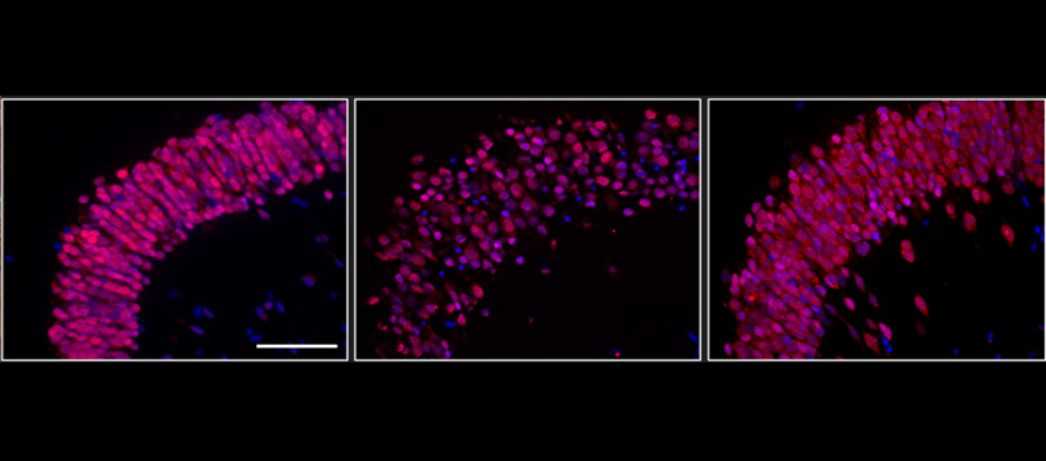
U of G Research Finds Geckos Can Regenerate Brain Cells
March 31, 2023
(The banner image shows neuron regeneration in a leopard gecko before injury, 4 days after injury, and 30 days after injury.)
Why can some species regenerate damaged cells while others cannot? To answer this question, researchers at the Vickaryous Lab at the University of Guelph’s Ontario Veterinary College (OVC) have been studying leopard geckos quite literally from head to tail.

“We have been gecko-centric right from the beginning!” said Biomedical Sciences professor Dr. Matthew Vickaryous, who founded the lab in 2008. “Our early investigations focused on the tail (many lizards – including leopard geckos – can self-detach their tails to escape predation, and then spontaneously regenerate a new one). Building on our studies, we began to look at other regions and organs of the body, including the skin, heart, inner ear, and brain.”
While geckos are not traditional models for regenerative research, as most studies use zebrafish or salamanders, they are more closely related to mammals and may one day provide a breakthrough into wound healing in humans.
A previous study in the Vickaryous lab documented the gecko’s ability to routinely form new brain cells as part of daily life. After dividing, new brain cells were tracked until they ultimately became new neurons in the medial cortex, an area that corresponds to the human hippocampus or memory centre.
To understand if geckos can regenerate the same neurons after injury and whether neuron regeneration restores brain function, graduate students Laura Austin and Chloe Graham conducted additional research.
“Four days after injury, we observed microglia invading the injured area of the gecko’s brain,” explained Austin. "In geckos and in mammals, microglia are immune cells found in the brain and in the spinal cord that clean up the wound and promote tissue repair."
Within 30 days, injured geckos had regenerated all the missing neurons and the once invading microglia had returned to a resting state. This short-term activation of microglia may be one of the reasons geckos are more successful at neuron regeneration than mammals.
“By contrast, in mammals microglia are activated for a prolonged period of time during the brain healing process, which results in scar tissue formation,” explained Austin. “This is one of the reasons that injuries to the brain or spinal cord in mammals often result in permanent loss of structure and function.”

In a subsequent study, Graham looked at the brain function of the medial cortex in uninjured, semi-regenerated, and fully regenerated leopard geckos.
“The medial cortex plays a key role in spatial memory, helping us to remember where objects or places are in our environment,” said Graham.
As part of Graham’s study, geckos were placed in one arm of a plus-shaped maze and had to navigate to a hidden dish of mealworms.
The results showed that semi-regenerated geckos had a decreased ability to navigate the maze, making more errors and requiring more trials to learn the task. The fully regenerated geckos were much more successful, but still showed decreased performance compared to uninjured animals.
“It would be interesting to see if this group would continue to improve if given more time to regenerate, or if they plateau without getting full function back,” concluded Graham. “Working with the geckos in my project, I had a renewed sense of appreciation of how different animals can use their innate learning skills to solve different problems. Geckos likely aren’t encountering plus-shaped mazes in their natural habitat, but they were able to apply their instinctive abilities to solve this new problem.”
As the leopard gecko research in the Vickaryous Lab continues, future studies may take a closer look at the large stem cell populations in the gecko’s brain, another important key to the gecko's wonderous regenerative abilities.


“While microglia promote healing, stem cells provide new replacement nerve cells,” explained Vickaryous. A big part of the equation is the presence of pre-existing stem cell populations in the brain (which geckos have). What we do not know is why they have large stem cell populations (or maybe, why don’t mammals have large stem cell populations) and how do they make sure that these cells are only activated when needed?”
Laura Austin is currently working as the Technical Supervisor, Histotechnology in the Animal Health Laboratory at U of G.
Chloe Graham is currently working as a Medical Writer at Synapse Medical Communications in Oakville, Ontario.
This research has been funded by the Natural Sciences and Engineering Research Council of Canada (NSERC).
.png)